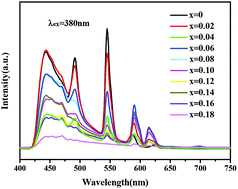Controlled synthesis and tunable luminescence of uniform YPO4·0.8H2O and YPO4·0.8H2O : Tb3+/Eu3+ nanocrystals by a facile approach†
Abstract
Uniform and well-crystallized YPO4·0.8H2O and YPO4·0.8H2O : Tb3+, Eu3+ nanocrystals have been successfully synthesized by a facile hydrothermal method using trisodium citrate (Cit3−) as a “shape modifier”. X-ray diffraction (XRD), field emission-scanning electron microscopy (FE-SEM), high-resolution transmission electron microscopy (HRTEM) and photoluminescence (PL) spectra were used to characterize the samples. It was found that the pH of the initial solution was responsible for determining the shape of the final products. In addition, the YPO4·0.8H2O samples prepared by Cit3−-assisted hydrothermal synthesis exhibited an intense and bright blue emission. Characterized with Fourier transform infrared (FT-IR) spectra and electron paramagnetic resonance (EPR) spectra, the carbon-related impurities induced by trisodium citrate (Cit3−) in the hydrothermal process were confirmed and confirmed that the paramagnetic defects relating to the luminescence properties existed in the luminescent YPO4·0.8H2O nanocrystals. More interestingly, the YPO4·0.8H2O : Tb3+, Eu3+ samples could be effectively excited with 380 nm and the luminescence colors of YPO4·0.8H2O : Tb3+, Eu3+ nanocrystals can be easily tuned by changing the concentration of Eu3+ ions due to an efficient energy transfer from Tb3+ to Eu3+. These results revealed that the combination of the defect luminescence and rare earth-doping emission in YPO4·0.8H2O : Tb3+, Eu3+ nanocrystals could result in tunable emission in a large color gamut, which may be potentially applied in fields such as solid state lighting and field emission displays.


 Please wait while we load your content...
Please wait while we load your content...